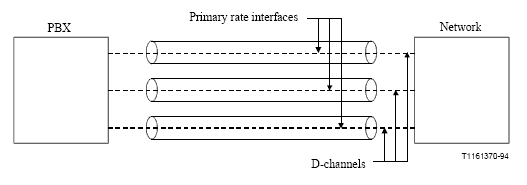
In associated signalling, the D-channel signalling entity can only assign calls to channels on the interface containing the D-channel. When the D-channel signalling entity can assign calls to channels on more than one interface (including the one containing the D-channel), this is called non-associated signalling. Figure F.1 is an example of associated signalling used on each of the three interfaces between a user (e.g. a PABX) and a network. Replacing associated signalling with non-associated signalling on these interfaces results in the example shown in Figure F.2.
When non-associated signalling is employed,the reliability of the signalling performance for the ISDN interfaces controlled by the D-channel may be unacceptable. To improve the reliability, a D-channel backup procedure employing a standby D-channel is necessary. The next subclause describes the backup procedure which is optional for end-points that use non-associated signalling.
Figure F.1/Q.931 – Example of associated signalling on each of the three primary rate interfaces
Figure F.2/Q.931 – Example of non-associated signalling controlling three primary rate interfaces